
Pulau Ubin, also simply known as Ubin, is an island situated in the north east of Singapore, to the west of Pulau Tekong. The granite quarry used to be supported by a few thousand settlers on Pulau Ubin in the 1960s, but only about 38 villagers remained as of 2012. It is one of the last rural areas to be found in Singapore, with an abundance of natural flora and fauna. The island forms part of the Ubin–Khatib Important Bird Area (IBA), identified as such by BirdLife International because it supports significant numbers of visiting and resident birds, some of which are threatened. Today, the island is managed by the National Parks Board, compared to 12 agencies managing different areas of the island previously.
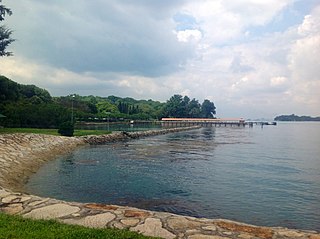
Saint John's Island also known as St John's is an island in the Straits of Singapore located 6.5 km off the southern coast of Singapore. With an area of 41.23 km2 (15.92 sq mi), it is the largest of the Marine Park islands which also include the Sisters' Islands and Pulau Tekukor. St John's was colonised by the British along with mainland Singapore in the 19th century and was the site of a colonial quarantine centre. In the 20th century, the island served as a detention centre, drug rehabilitation centre and refugee settlement. Singapore gained independence under the Government of Singapore in the mid-20th century and maintained sovereignty over St John's. In the present day, the island has doubled as grounds for recreational facilities and aquaculture research and development facilities.
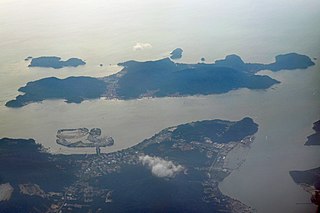
Pangkor Island is an island in Manjung District, Perak, Malaysia. It has a population of approximately 10,000. Nearby islands include Pangkor Laut Island, Giam Island, Mentagor Island, Simpan Island, and Tukun Terindak Island. The major industries of the island are tourism and fishing.

The Southern Islands is a planning area consisting of a collection of islets located within the Central Region of Singapore, once home to the native Malay islanders and sea nomads before they were relocated to the mainland for urban redevelopment and future use. The islands that form the planning area are Kusu Island, Lazarus Island, Pulau Seringat, Pulau Tekukor, Saint John's Island, Sentosa and the two Sisters' Islands. The islands encompass a total land area of about 5.58 square kilometres (2.15 sq mi). The Sentosa Development Corporation oversaw the development and maintenance of these offshore islands south of Singapore from 1976 to March 2017, when it handed it back to the Singapore Land Authority.
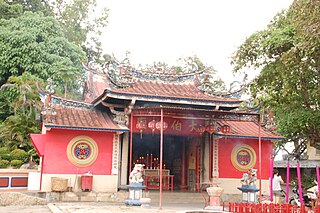
Tua Pek Kong is a Taoist deity in the pantheon of Peranakan folk religion practiced by ethnic Chinese in Malaysia, Singapore, and parts of Indonesia.

Na Tuk Gong are local guardian spirits worshipped by overseas Chinese communities in Malaysia, Singapore and parts of Indonesia, especially Sumatra. An alternate more generic name for the cult is Datuk Gong, uniting Dato or Datuk from the local Malay word for 'grandfather', which is also used as an honorific title, and Kong or Gong from Chinese, also an honorific title. According to Taoist tradition, a Na Tuk Kong's could hold the official title 拿督尊王. It is important to note that Datuk Keramat, Datuk Gong and Na Tuk Kong all refer to the same deity. For the sake of clarity, the term Datuk, which is universally used to describe the spirit in Malaysia, will be used.
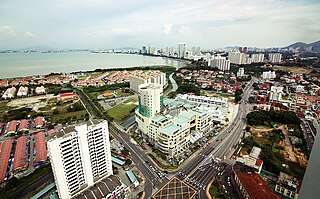
Tanjung Tokong is a suburb of George Town in Penang, Malaysia. It is located along the northeastern coast of Penang Island, next to Pulau Tikus and 4 km (2.5 mi) northwest of the city centre. Over the recent decades, the former fishing village has been transformed into an upper class residential suburb of George Town, with high-rises such as Straits Quay lining the coast.

Singapore Island or Pulau Ujong, is the main constituent island of the sovereign island country and city-state of the Republic of Singapore. It is located at the southern tip of Malay Peninsula, in-between the Straits of Malacca and the South China Sea. The Singapore Strait lies to the south, while the Johor Strait lies to the north.

Keong Saik Road is a one-way road located in Chinatown within the Outram Planning Area in Singapore. The road links New Bridge Road to Neil Road, and is intersected by Kreta Ayer Road.

Balestier is a sub zone located in the planning area of Novena in the Central Region of Singapore. The main road, Balestier Road, links Thomson Road to Serangoon Road and the road continues on as Lavender Street. The area is home to rows of shophouses, such as the Sim Kwong Ho shophouses, the Balestier Art Deco shophouses, 412-418 Balestier Road, and 601-639 Balestier Road, low-rise apartments and commercial buildings as well as a shopping mall known as Shaw Plaza. However, Shaw Plaza has since closed down and is under construction. Balestier also has another mall, Zhongshan Mall. There are several lighting and electrical shops along Balestier Road, which is also home to the Ceylon Sports Club and the Indian Association. The area is known for its food such as bak kut teh and chicken rice. In the area, there are several apartments, condominiums, and budget hotels.

The Goddess of Mercy Temple is a Chinese temple in the city of George Town in Penang, Malaysia. Situated at Pitt Street, it was first built in 1728, making it Penang's oldest Taoist temple.

Malaysian folk religion refers to the animistic and polytheistic beliefs and practices that are still held by many in the Islamic-majority country of Malaysia. Malaysian folk faith is practised either openly or covertly depending on the type of rituals performed.
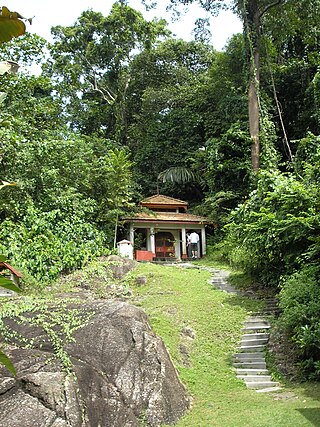
The religious belief of the Datuk Keramat worship can be found in Malaysia, Singapore and along the Strait of Malacca. It is a fusion of Malaysian folk religion, Sufism, and Chinese folk religion in Southeast Asia.
Loyang is a subzone region located in the town of Pasir Ris in the East Region of Singapore. The region consists of three subzones, Loyang West, Loyang East and Flora Drive. The name means brass or tray in Malay.

Fo Shan Ting Da Bo Gong Temple is a Chinese temple in Singapore located in Pulau Ubin.
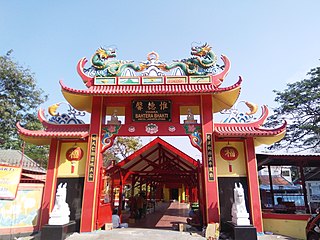
Vihara Bahtera Bhakti is a Chinese Buddhist temple located in Jakarta, Indonesia. The Chinese shrine, or klenteng, is located in the neighborhood of Ancol, hence it is more popularly known as Klenteng Ancol. It is dedicated to Da Bo Gong, a deity of land and wealth, and his wife. Established around 1650, it is one of the oldest Buddhist temples in Jakarta.

Chinese folk religion plays a dynamic role in the lives of the overseas Chinese who have settled in the countries of this geographic region, particularly Burmese Chinese, Singaporean Chinese, Malaysian Chinese, Thai Chinese and Hoa. The Indonesian Chinese, by contrast, were forced to adopt en masse either Buddhism or Christianity in the 1950s and 1960s, abandoning traditional worship, due to Indonesia's religious policies which at the time forbade Chinese traditional religion or did not recognize it as a "religion" thus making it vulnerable to discrimination. Some Chinese Filipinos also still practice some Chinese traditional religions, besides Christianity of either Roman Catholicism or Protestantism, of which some have also varyingly syncretized traditional Chinese religious practices with. Chinese folk religion, the ethnic religion of Han Chinese, "Shenism" was especially coined referring to its Southeast Asian expression; another Southeast Asian name for the religion is the Sanskrit expression Satya Dharma.

The German Girl Shrine is a shrine on the island of Pulau Ubin in Singapore. It marks the site of the burial of an unknown 18-year-old girl who died on the island in 1914 after falling from a cliff while fleeing from British forces who sought to detain a number of German nationals then resident on the island. Her body was recovered and interred in an urn on the site by Chinese workers, and a makeshift shrine structure was built. The site was visited frequently by gamblers who thought the spirit of the girl would bring them good luck. A permanent structure was erected in 1974 by a company carrying out quarrying on the island. Quarrying has since ceased, and the shrine is now within Ketam Mountain Bike Park. Visitors often leave offerings, including makeup and Barbie dolls, at the site.




















